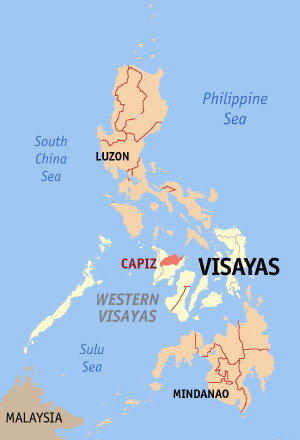Capiz became the second Spanish settlement after Cebu when Captain Diego de Artienda, sent by Legaspi landed in the town of Pan-ay and proclaimed it the capital of the province. The capital was then moved to the present location of Roxas City.
Folk history recorded in the Maragtas by Pedro Monteclaro says ten Bornean datus landed at a site now known as San Joaquin town in Iloilo province. They purchased Panay Island from the Aeta, cultivated the land, and renamed the island Madya-as. They divided it into three communities: Irong-irong, Akean (which includes the Capiz area), and Hamtik.
It is said that in Capiz in 1570, the Datu Bankaya’s wife of the Aklan district gave birth to twin daughters. Twin is "Kapid" in the local dialect, so the Spaniards adopted the name Capiz (Kapid) as inadvertently miscommunicated to them by the natives.
Capiz, which was part of Aklan in pre-Spanish times, was one of the early settlements of the Malays, centuries before the coming of the Spaniards to the Philippines. It was part of the Confederation of Madjaas, formed after the purchase of Panay by the Bornean datus from the Negrito king named Marikudo.
When the Spaniards led by Miguel López de Legazpi came to Panay from Cebu in 1569, they found people with tattoos, and so they called it Isla de los Pintados. How the island itself came to be called Panay is uncertain. The Aeta called it Aninipay, after a plant that abounded in the island. Legend has it that López de Legazpi and his men, in search of food, exclaimed upon the island, pan hay en esta isla!. So they established their first settlement in the island at the mouth of the Banica River in Capiz and called it Pan-ay. This was the second Spanish settlement in the Philippines, the first being San Miguel, Cebu.
In the same year of 1569 Captain ('Capitan') Diego de Artieda who was sent by Legaspi landed in the Town of Panay and proclaimed it as the capital of the province. Later, they moved the Capital to its present site upon discovering the town of Capiz (not the province, and now Roxas City) which was near the sea and provided docking facilities.
In 1942, the region was occupied by the Japanese troops. In 1945, the region was liberated by the joint Filipino and American troops with Filipino guerrillas from the defeated Japanese Imperial forces during Second World War.
Capiz and Aklan were united under one province until April 25, 1956, when President Ramon Magsaysay signed into law Republic Act 1414 separating the two entities.












